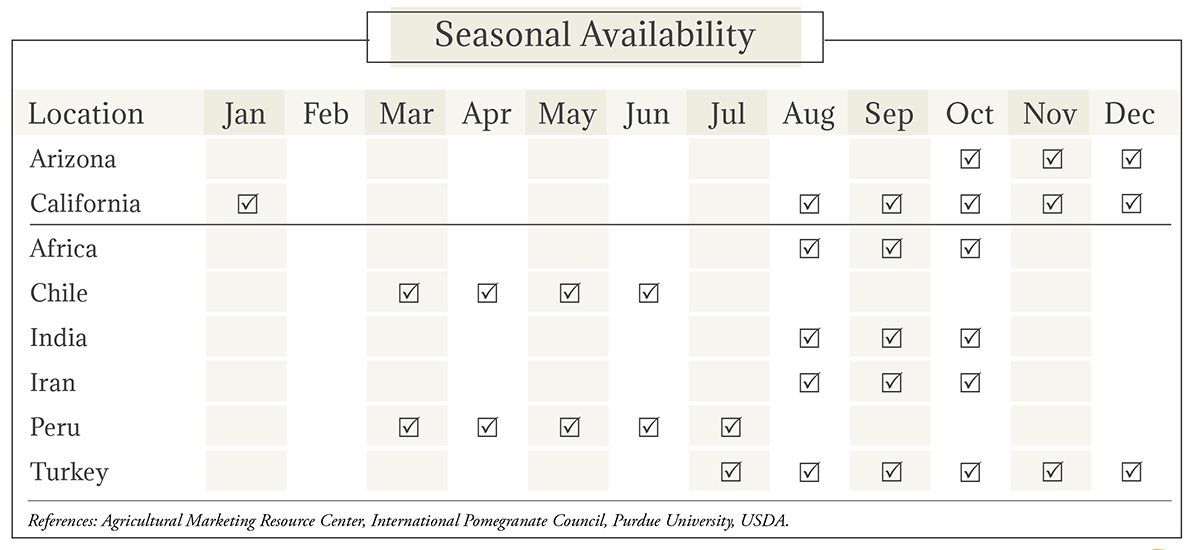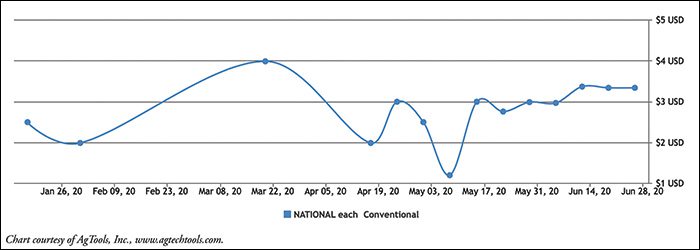Pomegranate Market Summary

Image: Mazur Travel/Shutterstock.com
Pomegranate Market Overview
The pomegranate, thought to have originated in Persia, was called Pomuni granatum or ‘seeded apple’ in the Middle Ages. The fruit adapts especially well to the cool winters and hot summers found in California or Arizona. Both temperature and humidity will affect growth; trees are typically 12 to 16 feet in height with stiff, spiny branches. While trees will lose much of their vigor after 15 years, many will endure for decades longer—as there are 200-year-old pomegranate trees still existing in Europe today.
Types & Varieties of Pomegranates
The most common variety of pomegranates found in the United States is the Wonderful, originating in Florida. It was cultivated in California as early as the 1890s, where it continues to thrive today. The fruit is large, purplish-red with a thick skin and light to crimson flesh. Other varieties include Cloud, Early Foothill, Francis, Granada, Green Globe, King, and Utah Sweet.Cultivation of Pomegranates
Well-drained soil is best for growing pomegranates, and though drought-tolerant after established, sufficient irrigation is necessary for good fruit growth. Pruning will help achieve a strong, balanced tree so plants should be cut back after reaching about 2 feet in height. Shoots will develop from each cutting and need to be distributed evenly around the stem. The fruit develops at the tips of new growth. Regular pruning is recommended to encourage new shoots. Pomegranates are picked 6 to 7 months after flowering when ripe, as the fruit does not ripen off the tree and ethylene treatment is ineffective. Fruit makes a metallic sound when tapped, indicating ripeness. Pomegranates should be clipped close to the base, not pulled off the tree. No stem on the fruit when harvesting lessens the likelihood of damage in handling and shipping. Pomegranates ship well when cushioned by paper or straw in wooden crates.Pests & Diseases Affecting Pomegranates
Pomegranate butterflies lay eggs on buds and the calyx (the green outside of the flower that protects the bud). Emerging caterpillars bore through the bud and sometimes right through branches. Fruit borers can damage an entire crop if not controlled, reddish colored mites hibernate under the bark on larger limbs and can cause russeting. One to two dustings of sulfur in June or early July will effectively control these pests. Other pests of concern include aphids, filbert worms, and leaf-footed plant bugs. The alternaria fungus causes heart rot and damages fruit internally, leaving the outside untouched. There is no known control fungus. Leaf and fruit spots are typically caused by the Aspergillus castaneus fungus.
Storage & Packaging of Pomegranates
Pomegranates have a long storage life if kept at proper temperature and humidity: up to 2 months if kept at 41°F with 80 to 85% relative humidity, and for longer periods at 45 to 50°F to prevent chilling injury. References: California Rare Fruit Growers, Purdue University, UC Davis Postharvest Technology Center, University of California Extension.Grades & Good Arrival of Pomegranates
Currently, there are no arrival guidelines specific to the United States or Canada for pomegranates. References: DRC, PACA, USDA.Inspector's Insights for Pomegranates
- Brown to black discoloration is a defect and may be caused by bruising or rough handling, scald, or chilling injury (if stored at temperatures below 41°F)
- Chilling injury can be identified when sunken, pitted spots are associated with discoloration; all surface discolorations are scored as defects based on appearance (if dark brown to black, it is scored as a defect when affecting an area greater than .75 inches in diameter—allow a greater area if discoloration is lighter in color; allow less if affected area is sunken or pitted)
- Sunburn can be found on the exposed side of fruit: it may appear as a yellow to golden brown discoloration and skin may crack in severe cases (sometimes sunburn will affect the flesh—as a guide, score as a defect when affecting more than 10% of the surface, or affecting the flesh)
- White surface mold found affecting the stem or calyx areas is not scored as a defect (most will dry up and disappear when exposed to drier air)
- Black surface mold is always scored as a defect; score when affecting an area greater than half an inch; be careful to search for decay with white, gray, or black mold.


